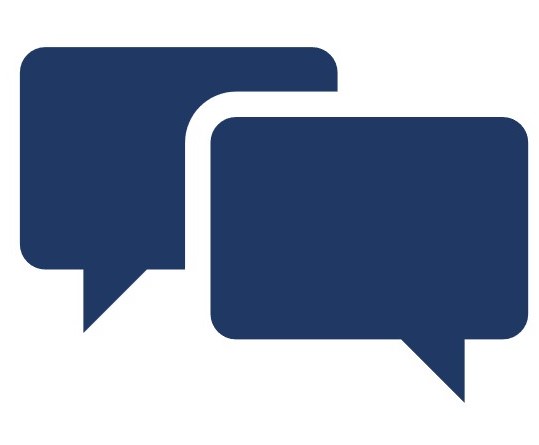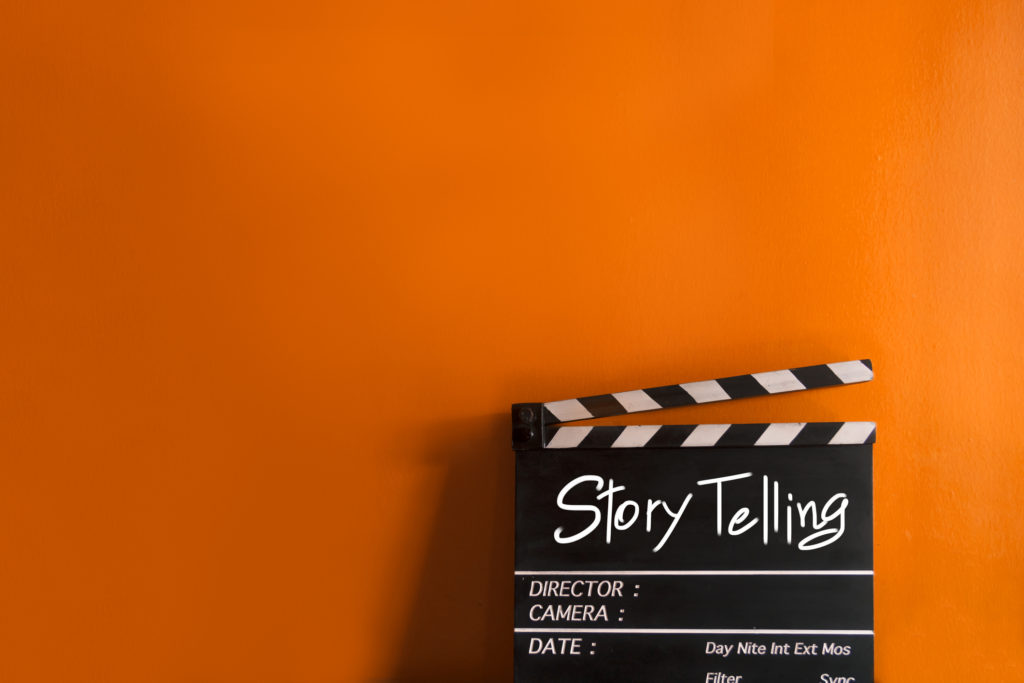We here at Throughline would like to get a few questions out of the way. “Does anyone really need media training tips? Is a media training 101 guide really necessary?”
After all, most of us are quite adept at the fundamentals of speech, thank you very much, and have used them to communicate our way to where we are today. It’s not like we are talking about algebra or physics. We are talking about talking, right? Isn’t it superfluous to train in something that is so automatic?
The simple answers are yes, yes, yes, and no.
The way we communicate in everyday life doesn’t automatically translate when we’re talking about two-minute live interviews or tightly edited quotes. Media interviewing requires a specialized approach. You have a message to share and a way you want to share it — and that might mean a few authentic adjustments to your usual speaking style.

Media Training Tips for Interviewing Success
Media training gives you greater influence over your message and the confidence that it will land how and where you intended — no matter the medium.
In this guide, we’ll focus on the media training tips, techniques, and best practices that help you to do just that. In the three sections that follow, we will cover the fundamentals of media communication: your messages, the methods through which you deliver them, and the media through which you express them.
Specifically, in the first section we’ll focus on the building blocks of a successful message, including:
- Structure — four types of messages that spokespersons depend on and audiences understand.
- Style — The four elements that increase the power and reach of your messages.
- Supports — The additional material, in the form of stories and statistics, that provide further context and meaning to your main points.
We move to the second section and methods to deliver your message, including:
- Interview Techniques — Six ways to stay on message.
- Nonverbal Communication — Four ways to let your body do the talking.
- First Impressions — Effective ways your appearance helps you to connect with your audience.
The third and final section, covers how your messages meet the world — through the media. We’ll focus on:
- Interviewing the Interviewer — The ground rules for pre-interview research.
- Focusing on the Format — The conventions of each medium and their effect on your message.
- Adapting Your Message to the Medium — Tactical approaches to adapt your message to fit the format.
If you are new to all this, that’s OK. There are few native speakers when it comes to media communication. Fluency is gained through immersion and practice. In our media training sessions, we have seen how effective media training tips can result in significant and noticeable improvement within hours (or less).
We started with some questions and will end our introduction the same way — but this time it’s just one. How can you use the media to successfully convey what you want to say to the people to whom you want to say it? It all begins with your messages.
Now, we’re talking.
Section 1: How to Build a Successful Message
 Do you know the game “Telephone?” It begins when the first player whispers an uncommon word, phrase, or sentence to the next person. That second player repeats that message to the third, and so on. It continues until the final person hears the phrase and whispers it to the first player. The object of the game is to keep the message from getting mangled or forgotten.
Do you know the game “Telephone?” It begins when the first player whispers an uncommon word, phrase, or sentence to the next person. That second player repeats that message to the third, and so on. It continues until the final person hears the phrase and whispers it to the first player. The object of the game is to keep the message from getting mangled or forgotten.
Those players are not unlike your audiences. One key difference is frequency. These days, people are bombarded with far more than just one message. During any given day, hundreds to thousands of messages stream into their consciousness from television, radio, computers, digital devices, and personal conversations. They may recollect some of what’s flown by, but odds are likely that it’s not much.
A successful message cuts through the clutter when it is catchy, when it is repeated, and when it is reinforced. Read on to discover the types of media messages, the elements all messages need, and the supports that will help you to share them.
1. What are the types of media messages?
At its most basic, a message is a one-sentence statement that incorporates two things: one of your main goals and one of your audience’s most important needs and values. A need can vary from something primal (survival) to something abstract (self-fulfillment). Values are guiding principles people share with others, such as a belief in democracy or the Golden Rule.
In its simplest form, a message reveals the two powerful dynamics that give it juice – you and your audience. A message caters to both, by answering why you do what you do and for whom you are doing it. As an example, you are a spokesperson for a nonprofit that focuses on financial literacy by providing free courses on money management and investment.
Here’s your message from your perspective:
“We are proud of the financial courses that we’ve put together for the community and hope people will attend them.”
Here’s one of the audience’s needs:
Financial security that builds savings for future needs.
Here is where they come together:
“You will learn specific techniques to get out of debt, build a nest egg, and build a stable future at our free family finance course next Thursday.”
It is important to have a deep understanding of your audience’s needs and values. When they are reflected in your messages, your messages are more likely to be heard, cared about, and acted upon.
Media messages typically fall into four categories, which you can mix and match. That exercise will come in handy later when we cover how to develop three main messages. As will this: The same message often can be adapted to fit each category.
1. Fact/Result
As the name implies, this message includes a fact and what happens because of that fact.
“One in three Americans do not get the amount of sleep they need each night,
which puts them in danger of developing chronic diseases, suffering injuries,
and getting into a motor vehicle accident.”2. Problem/Solution
The problem is revealed in the first clause and the solution follows. You also can flip the order.
“The third of Americans who say they do not get the amount of sleep they need each night can improve their chances of better rest with three simple measures.”
or
“By employing three simple measures, the third of Americans who report they don’t get enough sleep can improve their chances of getting better rest.”
3. Advocacy/Call to Action
You call upon the audience to get directly involved. We return to our financial literacy nonprofit:
“Gaining the power and expertise to make decisions about your money is a crucial step toward financial security, and, by signing up for our free classes, you will take a vital step toward a more promising financial future.”
4. Benefits
This type of message works when you are trying to get someone to buy a product or invest in a cause. For example, a local news program is interviewing you about your new restaurant. You might say:
“We are bringing back the comfort food we all loved as kids — mac and cheese, chicken pot pie, and homemade desserts — at about the same price it costs to make them at home.”
2. What does a message need?
Effective messages are consistent, free of jargon and wordiness, brief and catchy, and “ear-worthy.”
Once you develop those messages, they need to be consistent wherever and whenever they are shared. The words on your website should match the ideas you express on television. The message you give in a speech is the same as the one you post on social media. Repetition and reinforcement are keys to building long-term memories. It is why we remember 2 plus 2 equals 4, the address of our childhood home, and advertising jingles such as this one by a U.S. insurance company: “Like a good neighbor, State Farm is there.”
An effective message moves an audience from unawareness to awareness and on to the action you want them to take, whether that is advocating for change or buying the service or product you are selling.
Next, we break down a message’s four critical elements.
1. Consistency
Your local grocery store has reopened after a renovation radically adjusted the floor plan. Do you think your first trip back will take a.) more time, b.) less time, or c.) the same time? Our guess is a.) more time. Reorientation takes time and often induces unease and confusion. What the old plan had going for it, in terms of your needs, was consistency. If that store kept switching the floor plan every several months, would you keep going back? We suspect you would look for a different store.
Consistency makes it easier to remember — whether we are talking about groceries or a message. Memory retrieval is key to building an audience that internalizes your messages. Spokespersons who change their message from interview to interview prevent an audience from understanding, remembering, and acting upon their messages. Now, we understand not every interview will be a verbatim retelling of your key points, nor should it. For instance, the questions you receive from a technical journal, and the answers you give, may be different from those of a general-interest newspaper. The words might significantly change from audience to audience, but the big-picture themes stay the same.
Consistency transcends the messages themselves and is an important quality for an organization to embrace. No matter who in your organization is delivering them — a spokesperson speaking with a newspaper reporter, a CEO giving a speech, or a receptionist answering a donor’s question — the same message delivered with different words and different examples has a better chance of sticking.
2. Less jargon
If your audience must hack through the weeds to get to your message, then you are making them do way too much work. This happens when messages become overgrown with jargon or wordiness. Keep your words simple, concise, and interesting.
Say you are the transportation coordinator for a suburban school district, and you are letting families know about changes to the bus schedule.
You could say:
“By looking at mapping software and optimization techniques, we tweaked our algorithm and have found that fewer retrieval and drop-off sites and higher clusters of students at those sites will result in cost reductions to the town, as well as reductions in the duration of each route.”
What? Here’s a better way:
“There’s extensive research as to why we created new bus routes, but the bottom line is the new routes save money and cut the time your kids spend on the bus.”
One of the media training tips that is particularly useful is the “12-Year-Old Nephew Rule,” named in honor of a news producer who once interviewed a jargon-spouting scientist. After 20 minutes, the scientist’s answers were largely incomprehensible and not ready for prime time. She would have had nothing to air, until she employed a clever tactic just after the “official” interview ended. She thanked him and suddenly said, “Could I ask you a favor? My 12-year-old nephew loves science. Would you mind doing a take I could show to him?” The scientist agreed and delivered a terrific answer without any jargon — and that’s the quote the news program used that evening.
Most children and teens do not talk in highly technical terms, nor do most adults, for that matter. Run your messages by the young people in your life. If they can paraphrase them in their own words, you’ve successfully eliminated the jargon.
3. Brevity
News moves at a quick clip and your messages need to keep pace. A half-hour television news program, for instance, is just about 22 minutes long, after commercial breaks. The average quote airing on evening newscasts lasts just about 7.3 seconds, according to Harvard’s Center for Media and Public Affairs. That translates to about 18 words per quote, or a quick rendition of the “Happy Birthday” song. Most quotes in print, if read out loud, would run about the same length.
The message about the bus schedule, for instance, could be even shorter.
“We created the new bus routes to save money, save time, and get your kids home faster.”
4. ‘Ear-worthy’
A hit record has many things going for it, not the least of which is memorable lyrics and unforgettable melodies. Some songs become so ingrained in our brains that we can’t get them out of our heads. There’s a name for that — earworms. There is a similar principle at play in media messaging. They need to be ear-worthy. Your message sounds good when you say it and remains in the mind of the people who hear it.
Say you are a spokesperson for a small-batch ice cream maker named Just Chill. The company is launching a new flavor, chili chocolate, and your message needs to drive interest in the new product.
You could say:
“With its latest flavor, Just Chill brings on the heat, yet keeps it cool.”
3. What are message supports?
Earlier, we spoke about repetition. And, yes, these messages are what you are going to want to reiterate time and time again when given a chance to talk about your goals. You are not a parrot, however. You will need help from two supporting players.
Every message needs a supporting cast of stories and statistics to make it look good. They provide the color and texture and help audiences remember your main points.

1. Stories
Stories have been used for millennia, in the form of fables and parables, to express moral lessons and insights about human behavior. As those tales have endured, the stories you choose will help to make your messages memorable. They reinforce and intensify your message, which helps the audience to remember.
A story can be told many ways, such as through a personal experience, a case study, or a historical or fictional example. You can see how this story could help the financial literacy organization:
“I want to tell you the story of Sandra. She started taking our free financial classes about two years ago. She had no investment knowledge and zero savings. Today, she has $5,000 in her savings account, has lowered her credit debt, and is far less stressed about her financial future. She’s even started saving for her son’s college costs.”
2. Statistics
Raw numbers, ratios, and percentages have their stories to tell. However, they are difficult for most people to latch onto. They need some finessing. When numbers are personalized, they add heft and credibility to your messages.
Say you are a spokesperson for a group advocating for better screening methods to prevent strokes. During a radio interview in Wisconsin, you offer this as a statistic:
“Every year, more than 795,000 people in the United States have a stroke.”
That’s a big number, but without perspective it is just a number. Instead, you could say:
“Lambeau Field, home to our beloved Green Bay Packers, seats more than 81,000 people. It would take nine Lambeau Fields to hold the Americans who suffer a stroke every year. Nine! That’s 795,000 strokes that may have been prevented with better screening.”
In this section, you have learned how to develop several effective messages that you are ready to share. We now turn to the work of making those messages even more memorable.
What is your message?
Here’s the part where you start working on your message, or, more accurately, messages. In general, you should aim to have three, as it’s a good balance between too few and too many. Treat them as if they are a trio of great musicians who formed a supergroup. They are exponentially better when they come together.
Here’s your exercise:
- Start putting some of your main messages to paper. It doesn’t matter whether you type or write them out, just brainstorm. Put down whatever comes to mind — words, phrases, or complete sentences. These concepts should reflect the “wants” of you or your organization. Save them and put them away. Come back in a few days and add anything you may have forgotten.
- You now move on to the needs of your audience. As before, you will brainstorm whatever comes to mind. It doesn’t matter if these are merely words or phrases. What does matter is that they reflect deep needs and wants of your intended audience. Put the list aside for a few days. When you come back to it, see if there is anything you want to add.
- The final step is to look for ideas that correspond. Does one of your goals fit an audience need? If yes, you begin to refine those messages. If not, revise your messages to put them in context of what your audience needs.
- Now that you have winnowed your list to three that most represent you and your audience, go back to any of the examples in the previous section (the ones that work!) and write a sentence for each main thought. This will take time, so do not be discouraged.
- Next, read the final messages aloud. Are they consistent, brief, free of jargon, concise, and catchy? Have you used three words when you could have used one? This is not the time for sesquipedalian prose. Keep them simple, short, and conversational.
Section 2: How to Deliver Your Message
The methods you use to deliver your messages are crucial to making them stick. In other words, what you say can be as important as how you say it. By teaming the right words with the right actions and right look, you more effectively convey your most important points. We offer the following media training tips on how to better deliver your message through interview techniques, nonverbal communication, and first impressions. Savvy communicators know how to do this, and so can you.
Interview Techniques
Your message is only as good as your ability to deliver it. These media training tips will help you to navigate some of the more difficult moments during your media interviews. Here are six ways to stay on message:
1. Mix It Up
We may have mentioned this once or twice, but it bears repeating: Repetition is a strength, not a flaw, when it comes to your messages. Still, one of the easiest ways to annoy a reporter and lose your audience is to repeat the same message in the same way in every answer. There is an art to employing repetition without sounding repetitive. You want to express the same idea, or theme, in every answer without relying on the same words to do so. You already have the tools to do that. For every main point, have a mix of stories and statistics ready to go
Here’s how it might work during the interview:
- Answer 1 — Deliver one of your main messages.
- Answer 2 — Say, “Let me put this in context,” and offer a statistic.
- Answer 3 — Offer an example.
Each of those replies carries your main idea — either through the message itself, a supporting statistic, or an illustrative example. They allow you to stay “on theme” without being redundant.
2. Begin at the End
If your message meanders, then you may lose your audience along the way. The familiar flow of most stories and conversations — beginning, middle, and end — can be an ineffective tactic for media interviews for at least three reasons:
- You fail to immediately grab the audience’s attention.
- You run out of time to arrive at your main point.
- You get cut off by an interviewer eager to ask a follow-up and never get to your conclusion.
What are the solutions?
One of the more effective media training tips in helping you to get your message across is to flip the typical narrative flow and begin each answer with the most important point — end, beginning, middle, and end. Captivate your audience early on by expressing a dramatic conclusion, fantastic punchline, or surprise twist before moving on to the details.
3. Build a Bridge
Not too many baseball pitchers are happy when an opposing hitter gets a hold of the ball. They keep batters guessing with an arsenal of pitches, including curveballs, heaters, sliders, and changeups.
Similarly, reporters feel no responsibility to deliver up the “right” questions that allow you to knock your messages out of the park. The questions coming at you can be difficult, off-topic, and sometimes hostile.
The best hitters know how to adjust to each pitch. Effective media spokespeople know how to adapt to the challenge, too.
They do this by constructing a textual bridge that takes the audience from the reporter’s question to the spokesperson’s message. It’s a deft way to acknowledge the question, even as you are clearing the path toward the answer you really want to share. It requires tight transitions from your initial response to your final point. Here’s how it works:
Reporter
“Your plan to close the town libraries on Sundays has led to numerous complaints throughout the community. At any time, did you think about the effect on patrons?”
Your Answer
“Absolutely.”
The Bridge
“The key consideration for us was…”
You Arrive at the Other Side
“…how we can continue to serve our visitors with the level of service they’ve come to expect from us. That’s why, when asked to find ways to cut our budget, we targeted areas that had the least impact on programs and services. We have the fewest number of visits and events on Sundays, and we wanted to make sure our visitors continued to have a great experience on the six days each week they visit most.”
4. Employ the Redirect
There’s also always the redirect. If you have the opportunity after answering a direct question, you can extend your answer by saying something like:
“There’s one other point worth mentioning.”
5. Use the Final Seconds
At the end of many interviews, reporters will ask whether there’s anything else you’d like to add. Most interviewees are so relieved their interview has come to a close that they decline that golden opportunity. It’s media training 101 to never squander the chance to reiterate a point you made earlier or state a message you failed to deliver. Another tip: If you mangled an answer during the interview, use the final question to offer a cleaner version of that response. Reporters can choose either — but for most stories, your cleaner version serves your interests and theirs better.
6. Avoid the Seven-Second Stray
In fairy tales, the problems often begin when characters stray from the main path. When it comes to media interviews, we call that the seven-second stray. If you’re on message for 59 minutes and 53 seconds of an hour-long interview but utter a sarcasm or offer an unsolicited personal opinion during those other few seconds, there’s a good chance the reporter will use it.
Don’t stray in your role as a spokesperson. At best, extemporaneous, off-message responses about personal beliefs or comments on an irrelevant subject take time away from the points you are there to deliver. At worst, your flip remark could end up being the only part of the interview the reporter uses.
As a spokesperson, you want to tell the story, not be the story.
In this video, Throughline’s Chief Executive Brad Phillips and Partner Christina Mozaffari share three media interview tips and techniques on how to keep your message front and center in any media interview.
Throughline: Three Media Interview Tips from Throughline Group on Vimeo.
Nonverbal Communication
So far, we have focused on words, but messages are broadcast through body language, such as movements, eye contact, vocal tone, and gestures. Visual impressions can enhance the effectiveness of your words. Audiences are better able to remember, receive, retain, and retrieve your messages when there is an authentic connection between actions and words. Among the media training tips we share with our clients how to effectively employ body language. Such a skill is particularly useful for on-air interviews, but it will work with any media.
Here are four ways to let your body do the talking:
1. Energy
Right at the top, we want to encourage engagement and warmth. Many spokespersons think they must bury their most engaging traits to emerge as an “official” or “credible” spokesperson. Why would anyone bury the qualities that are most likely to draw people to them? Engaging and compelling communicators, who share their passions and beliefs in a natural and authentic manner, will connect with audiences.
Pump up the energy. Many people tend to overestimate the energy they’re projecting. Often, people don’t start looking their best until they feel as if they’ve gone too far. To gauge the energy level that’s right for you, take a few videos of yourself while speaking. Use your regular delivery for the first take, a slightly more energetic version for the second, and an “over-the-top” delivery for the third. You may discover that the third take is not “over-the-top” at all, but, rather, the best version of you when it comes to interviews.
2. Voice
Voices are important instruments in conveying messages. Emotional stories or tragic statistics are whispered. A key point arrives loud and clear. A dramatic story unfolds with a quickening pace. Whether you are talking on television, conducting a phone interview, or speaking as a guest on a radio show, your volume, pace, and tone are additional cues for the reporter and audience. One way to draw additional attention to your message is to alter your volume and pace just before you deliver it. If you tend to speak energetically, slow down as you reach your main point (the change of pattern will attract attention). If your conversational style is slower and softer, increase your pace when leading up to your message.
3. Eye Contact
Nearly 100 percent eye contact may seem to be another way of saying “staring contest.” It’s actually the recommended dose of focus when it comes to media interviews. However, when we normally speak, we rarely hit that mark. Our eyes tend to wander as we try to access information from our brains — where we look depends on what we are trying to retrieve. In the context of a media interview, the lack of eye contact can signal unease or nervousness at best, evasiveness or defensiveness at worst. Here are two ways to make this all work:
Before the interview, go over your main points and supporting facts until you have internalized them. Doing so will reduce the amount of time you have to look away to “download” information when you’re live.
If the interview isn’t live, pause for a few seconds before answering a question, which will allow you to access the information you need before you begin speaking.
4. Gestures
Your goal during a media interview is to appear as natural on camera as you are in person, and almost everyone gestures naturally when they speak. Gesturing enhances the impact of your words. Several studies have found that gestures not only increase the effectiveness of your speech (just try giving directions with your arms pinned to your side), but can also increase the perceived credibility of your message. When your words and the manner in which they’re expressed are aligned, the two channels send a consistent message.
When we work with our clients, their words often get better the more they incorporate their natural gestures into their delivery. Here’s some advice: Avoid clasping your hands, crossing your arms, placing your hands behind your back, and hiding both hands in your pockets. Instead, nest your hands within one another and place them on your lap, if seated, and by your navel if standing. This leaves you free to gesture.
First Impressions — Dress the Part

As with your physical presence, clothing and cosmetic choices influence how the audience perceives you. Simply put: your outward appearance is another “support” to your main message. Even simpler: Content should drive attire.
There is no single rule, however, of what that appearance should be. A male CEO may appear in a suit for an interview on a television business program, then opt for a sweater and slacks for an interview in the factory with his workers. An up-and-coming fashion designer who specializes in outlandishly sized barrettes might wear a few in her hair. A distraction? Yes. Are you concentrating on that neon clip and not her words? Yes. Does that matter? Maybe not. If her point is to come off as edgy and bold, she just managed to do that.
In this section, we shared many media training tips that will help you to reinforce your messages. We now shift to the work of understanding the channels where messages are expressed.
Section 3: How to Share Your Message
Today’s media landscape is a mix of the old and the new. Traditional sources, such as newspapers, publications, and journals continue to rub elbows with radio and television — once upstart technologies. Meanwhile, social media platforms increasingly upend the way audiences access their news.
You become a more effective spokesperson when you know how best to work with each of them. In our final section, we offer media training tips on how to be your own best reporter — from the questions you ask and the way you share your message.

1. Ask the Fundamental Question
Before we get too deep, it’s time to cover some media training 101 ground rules for working with the media. We begin at the fundamental question, “Should I agree to the interview?” If the story will be written about your organization with or without your participation, then the answer is usually “yes.” You can’t guarantee what the reporter will write, but you can help guarantee that your voice or your organization’s voice will be represented.
A “no” might be the better response if:
- the topic is not relevant to your work;
- you question whether it is a legitimate news outlet;
- the story is not specifically about you or your organization. Rather, you are being asked to comment on a topic that you’d rather not be associated with, such as failing businesses;
- you gain nothing by doing it;
- the reporter or news organization is so loaded against you, historically, that being absent is better than being present.
2. Interview the Interviewer
Assuming you decide to proceed, it’s time for you to ask some additional questions. Your tone can be conversational, but your approach should be all business. The reporter may or may not choose to answer, but any information is helpful.
Here are five questions to ask:
1. Who Are They?
Who is the reporter? What types of stories does the reporter write? What topics does the reporter cover?
2. What’s the Story?
Most journalists don’t mind offering a thumbnail sketch of the topic or perspective of the story, but they tend to bristle when asked, “What’s the angle?” They’ll lay their cards on the table when the story breaks. Until then, you could ask, “Can you tell me about the story you are working on?”
3. Who Are the Other Players?
You may not get an answer. However, it doesn’t hurt to ask if the news outlet is intending to include other voices. That information can help to discover the tone of the story and the topics to research during interview preparation.
4. What’s The Format?
Does the reporter intend to cover a short list of questions or more in-depth topics? For television, ask whether it will be live, live-to-tape, or edited (same goes for radio or podcasts). Also, make sure you know whether this is a call-in or in-person interview.
5. When Can You See It?
When is the publication date? When will your segment be broadcast?
As part of your research, spend some time online getting to know the reporter’s news organization and his or her work. Be your own reporter. This search may give you ideas for the questions you will be asked and the messages you may need to refine.
While you are there, it’s a good idea to do a search on yourself and your organization. The exercise lets you know what the reporter is going to know and gives you time to develop answers to explain positions that may have changed or clarify any misconceptions.
3. Focus on the Format
The news today is delivered through print publications, radio and television, online outlets, and social media. While your messages do not change, you may need to adapt them to best utilize each medium’s pace, reach, and audience.
Television
Even in a 24-hour news cycle, your time with the reporter or host often is limited, as is the attention span of the viewers. It’s best to approach your screen time with the precision of a surgeon. You need to maximize your minutes to make your messages stick.
Here are some tips:
- Bring out your most compelling thought first. This advice works well with any media, but it is particularly crucial in live television. If you have more time, you can delve into your message supports for details.
- Don’t let your attention stray and avoid statements that do not tie back to your message. You have no control over how the piece is edited, but you have control over the material you give them to edit.
- Try to avoid terms such as “yesterday,” “today,” and “tomorrow,” unless you know when the story is running. Even then, it is best to be specific in case the piece airs at a future date or is re-broadcast.
- Don’t think about the masses that might be tuning in to your interview. You are not talking to millions of people. You are having individual conversations with all of them. Focus on the one person you want to reach, and that natural connection will be magnified. If you reach one person, you reach almost everyone else, too.
- Although your body language and attire have implications in virtually every medium, including those in which you will never be seen, the way you act and look has particular importance for television.
Newspapers/Magazines/Journals
Print reporters typically write for two formats: print and web. The format often dictates the length and type of interview (by email, phone, or in person), which may affect the depth of material you need to cover and how you deliver your messages. Those are important aspects to keep in mind, along with these media training tips:
- As you share your subject matter expertise, avoid downloading your knowledge. Instead, prioritize it. Your main goal is to influence the story and deliver your messages. As you provide the facts, put them in the context and meaning of your goals and the goals of your organization.
- Our clients often will ask, “Out of everything I gave the reporter, why did she use THAT quote?” She used it because they said it. Give yourself permission to leave your secondary or tertiary points at home, or they may be the only ones included in the story.
- You can be warm and authentic with the reporter, but remember your words are intended for your audience. This is a strategic interaction and not a conversation. Try to avoid going down the side roads reporters may want to travel. Keep redirecting them to the main road.
- Print media interviews can be longer than those for television. Before the interview, review your messages and supports to ensure there is a mix of materials to reiterate the main points without being redundant.
Radio
Radio’s tone is often conversational, and public interaction can be high — particularly on shows that take listeners’ calls. Radio interviews may appear informal and downright conversational, but the stakes are high.
Since it’s easy to stray, here are a few tips to keep you on track:
- Be friendly, warm and on point. Come armed with main points and supports that are dynamic and conversational.
- Express your main messages early, and then return to them often throughout your interview — with different words and examples — to introduce them to new listeners who joined the interview midway and to keep the faithful listeners from tuning out.
- Use your voice to add emphasis and drama. If on the phone, stand to project more energy.
- Try to match or slightly exceed the host’s energy level to avoid sounding flat.
Blogs
![]() Blogs may have started as personal, online journals, but they have evolved into commercial and influential publications that can reach millions of readers. The same rules for newspapers and magazines apply here, as well as some additional considerations. In this example, a blogger has asked you to answer some questions by email for a future post.
Blogs may have started as personal, online journals, but they have evolved into commercial and influential publications that can reach millions of readers. The same rules for newspapers and magazines apply here, as well as some additional considerations. In this example, a blogger has asked you to answer some questions by email for a future post.
Here are some suggestions:
- Treat your responses as you would a phone or in-person interview. Your responses represent your “quotes,” which help your messages to stand out in a block of text.
- After your write your response, read it out loud. There should be a vibrancy and illustrative quality that transcends the staid structure of the format. Your words on the page should look like they were spoken aloud — not edited by a committee.
- Make your most compelling point more than once, in different ways. There is no guarantee all the questions you answered will be used.
- If your interview is to run verbatim, vary the length of your responses. It will have a cadence and pace that will keep a reader interested.
Podcasts
![]() Like radio, guests are interviewed by a reporter or host during a podcast. The conversation is recorded and becomes a digital audio file that can be downloaded or streamed. The programs can run several minutes to more than an hour. Much of the advice for a radio interview is applicable for podcasts. Here are two additional items to consider:
Like radio, guests are interviewed by a reporter or host during a podcast. The conversation is recorded and becomes a digital audio file that can be downloaded or streamed. The programs can run several minutes to more than an hour. Much of the advice for a radio interview is applicable for podcasts. Here are two additional items to consider:
- Podcasts may be downloaded months and years from when they first “aired.” If it is not too clunky, try to work in specific dates to avoid the dilemma of “yesterday, today, or tomorrow.”
- The audience tends to listen to a podcast sequentially, from beginning to end. It is particularly important to be on message at the top, which virtually everyone will hear. You can assume that the audience will shrink as it continues, as not everyone will make it to the end — meaning you can go a little longer with your examples as the podcast continues.
What’s Next?
Learning a new way to communicate requires practice. These media training tips and techniques are only effective when they are used.
Go ahead and return that reporter’s phone call or agree to that television interview. These are opportunities to implement what you have learned and to assess where you need to grow. Did you nail that quote? Did you cover your main points? Did your body language convey the conviction you genuinely feel? If the answers are not the ones you want, you know what to do.
If this sounds a bit daunting, however, you can always start small. Don’t expect to master all the tips and techniques right way. Seek out a community radio or television station, connect with a local podcaster, or reach out to a reporter at a weekly publication. Inexperienced runners do not strap on their shoes one day and complete marathons the next. They train by running many, many miles, more efficiently and quickly each day.
On Your Way to Media Interviewing Success
With the exception of a lucky few, savvy communicators are not born that way. They grew into their skills by immersing themselves in various forms of media where they could refine and reinforce their messages. They know how best to utilize the media to broaden their reach. And, they possess the confidence to stay in control during an interview.
Effective spokespersons build successful media presences by creating memorable messages that are delivered in ways that make their messages even more memorable.
As you have now learned, these are skills that can be acquired. The media training tips and techniques in this guide are field-tested and spokesperson approved. When we work with our clients at our executive media training workshops and other sessions, they experience a noticeable improvement in as little as an hour or two.
You believe in your product or service. You know the world will be a little better if people learn about it. So, what are you waiting for?
Expand Your Media Communication Skills
Our training workshops are packed with practical guidance that leads to immediate improvement.

 Not too many baseball pitchers are happy when an opposing hitter gets a hold of the ball. They keep batters guessing with an arsenal of pitches, including curveballs, heaters, sliders, and changeups.
Not too many baseball pitchers are happy when an opposing hitter gets a hold of the ball. They keep batters guessing with an arsenal of pitches, including curveballs, heaters, sliders, and changeups. At the end of many interviews, reporters will ask whether there’s anything else you’d like to add. Most interviewees are so relieved their interview has come to a close that they decline that golden opportunity. It’s media training 101 to never squander the chance to reiterate a point you made earlier or state a message you failed to deliver. Another tip: If you mangled an answer during the interview, use the final question to offer a cleaner version of that response. Reporters can choose either — but for most stories, your cleaner version serves your interests and theirs better.
At the end of many interviews, reporters will ask whether there’s anything else you’d like to add. Most interviewees are so relieved their interview has come to a close that they decline that golden opportunity. It’s media training 101 to never squander the chance to reiterate a point you made earlier or state a message you failed to deliver. Another tip: If you mangled an answer during the interview, use the final question to offer a cleaner version of that response. Reporters can choose either — but for most stories, your cleaner version serves your interests and theirs better.